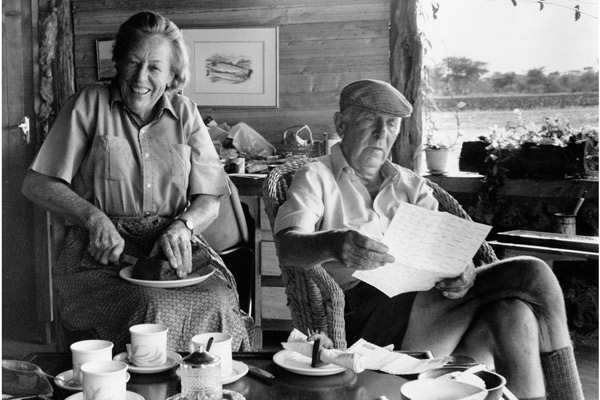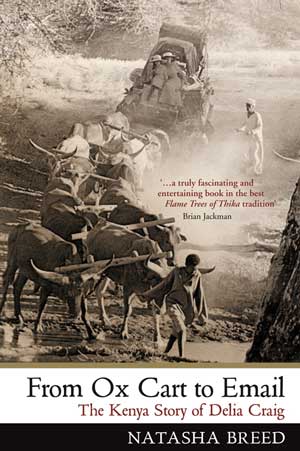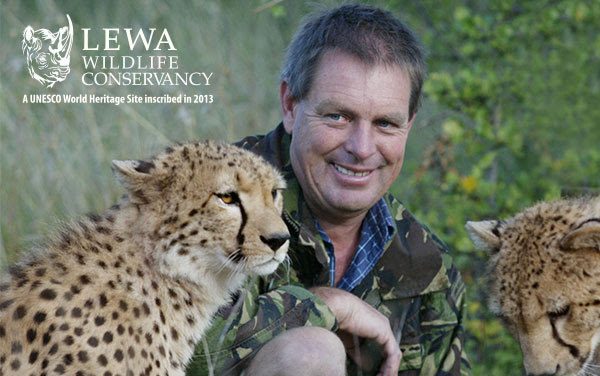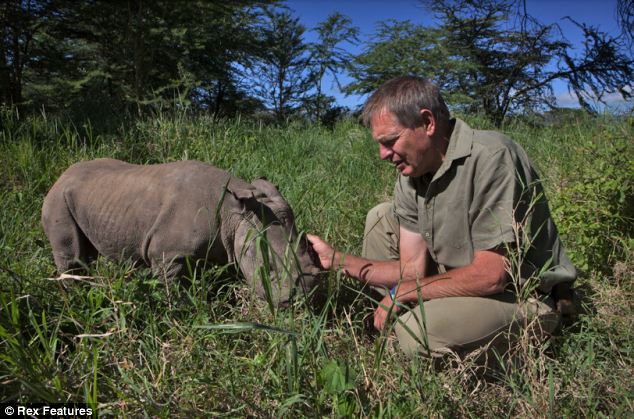Craig Family
A proud Kenyan conservation family..
The Craig Family - true legends of wildlife conservation in Kenya
Pioneers in rhino conservation and the first private ranch in Kenya to become a wildlife sanctuary.
Delia Craig, known as Mama, inherited Lewa Downs from her father, Alexander Douglas. Along with her husband, the late Mzee David Craig, they promised Alexander that there would always be room for wildlife on Lewa, a promise which they saw fulfilled when they established the Ngare Sergoi Rhino Sanctuary with the late Anna Merz in 1983. Ngare Sergoi was later reinvented as the Lewa Wildlife Conservancy in 1995. Of all the people who have shaped Lewa into the world-class conservation initiative it is today Mama reserves a special place. She was bold, vivacious and loved the wildlife as much as the land it inhabited. Mama's life story was immortalized in a biography by Natasha Breed, titled From Oxcart to Email. "Everyone called her Mama because she was not just our mother, but mother to the entire of Lewa." Ian Craig, Lewa's co-founder and renown conservationist.
Ian Craig converted his family’s 40,000-acre Kenyan cattle ranch into a wildlife and nature conservancy after witnessing an elephant massacre in 1988. Raised in Kenya, Ian realized that wildlife had no future unless local communities participated in its protection. The organization he founded, the Lewa Wildlife Conservancy, has a mandate to protect and conserve Kenyan wildlife and is now active worldwide.
Delia Craig is the matriarch of the Craig Family who founded the Lewa Wildlife Conservancy and whose offspring are still running Lewa Wilderness (Delia’s son Will) and Lewa House (Delia’s granddaughter Sophie). Delia was born in Kenya in the 1924 and her parents starting farming in Lewa in 1927 where she grew up. In 1946, Delia married Douglas Craig and they settled at Lewa where they had 3 children, Sue, Ian and Will. In 1970, they introduced walking safaris at Wilderness Trails and a few years later they created the world famous rhino sanctuary – the Lewa Wildlife Conservancy. The conservancy is now home to the Big Five, 30% of the world’s population of endangered Grevy zebra and countless other species of wildlife. Delia and her family have welcomed guests to Lewa since the 1970s and have continued to embrace their motto “leave room for the wildlife”. A wonderful book about Delia and her life at Lewa, “From Ox Cart to Email”, has been written by Natasha Breed.
Delia’s parents, British immigrant Alexander Douglas and his wife Elizabeth Cross, moved into Lewa and started a cattle ranching enterprise that they ran for over five decades but when time for handing over the mantle came, Delia told her father that she wished to reserve 5,000 acres for establishment of a rhino sanctuary — Ngare Sergoi.
Delia was brought up at the ranch and withstood the Mau Mau rebellion. But even when pressure on white settlers to quit was intense, she and her family chose to remain in Kenya through to independence at which time she was among a group of white settlers who later became naturalised Kenyans following independence. Her story is captured in Natasha Breed’s novel - From Ox Cart to Email The Kenya Story of Delia Craig that describes her as an indomitable woman who made Africa her home.Wildlife author and photographer, Jonathan Scott, best described her as “a hardy and resourceful matriarch. I hope that with the help of remarkable people like the Craigs, there may still be a chance to preserve a fragment of Africa’s wild places”.
Born in 1924, Delia Craig and her husband were blessed with three children — Sue, Ian and Will — who paid glowing tribute to their mother and pledged to carry on with her legacy.
In his glowing tribute to his mother, her son, Ian, broke the sad news saying his mother had lived to fulfil her dream to her father by bequeathing Kenya and the world a lasting gift for rhino’s to breed freely and help restock other wildlife sanctuaries around the country.
“Of all the people who have shaped Lewa into the world-class conservation initiative it is today, Mama reserves a special place. She was bold, vivacious and loved the wildlife as much as the land it inhabited. Everyone called her Mama because she was not just our mother, but mother to the entire of Lewa,” said her son Ian, Lewa’s co-founder and renowned conservationist. Delia ‘gave’ her life to conservation of 30 per cent of the world’s Grevy Zebras population as well as rhinos and elephants attracting an array of famous visitors to Lewa Wildlife Conservancy. The conservancy is home to some of the continent’s most endangered species the black rhino and the Grevy’s zebra and a plethora of other wildlife including the elephant, giraffe, buffalo, antelope, lion, cheetah and leopard.As the conservancy grew in stature, Mrs Craig spent her entire life convincing her neighbours that there was ‘sustainable’ money in wildlife and forest conservation.
Courtesey: Bush-and-Beach blog and Daily Nation
ABOUT IAN CRAIG
Ian Craig is world renowned for his work in creating and directing The Lewa Wildlife Conservancy www.lewa.org, both for Lewa's phenomenal conservation achievements and its community development success. Lewa is the leading sanctuary for black rhinos and Grevy’s zebra in east Africa, and provides a secure environment for a host of other endangered or threatened species. The Conservancy is also famous for its provision of health clinics, schools, and water supplies, and for providing advisory assistance in agriculture, livestock management and reforestation to its surrounding communities.
The Lewa model’s phenomenal success in integrated conservation and community development has been adopted by the recently created 90,000+ acre Ol Pejeta Conservancy (Lewa now manages this conservancy), and by the 15 communities that have created their own conservancies in forming the 1.5 million acre Northern Rangelands Trust in the large region to the north and west of Lewa.Ian’s involvement with communities goes back thirty years and comes from a common background in livestock management and an unrivalled passion for Kenya, its people and wildlife.
After completing secondary school in Ireland, Ian Craig returned to Kenya to manage the family cattle ranch until the Ngare Sergoi rhino sanctuary was established on Lewa in the early 1980s, at which time he took over all aspects of wildlife management and conservation. In 1995, when the entire ranch became The Lewa Wildlife Conservancy (Lewa), Ian became the Executive Director. In early 2004, Ian pioneered the establishment of the Northern Rangelands Trust, the community led initiative that develops the capacity and self sufficiency of its constituent members in Northern Kenya in the areas of biodiversity conservation, natural resource management and natural resource-based enterprises. Ian served as Lewa’s Executive Director until early 2008. In the spring 2008, Ian became the Strategic Advisor to Lewa, the Northern Rangelands Trust and to Ol Pejeta. Ian is a very experienced pilot with over 6,500 flying hours and carries out all the radio-tracking and aerial surveillance of wildlife within Lewa, and the community conservation areas north of Lewa. As an honorary warden, Ian also undertakes all veterinary aspects of wildlife capture and treatment in conjunction with the Kenya Wildlife Service. He received formal training in the capture and immobilization of wildlife in Zimbabwe.IAN CRAIG AWARDED ORDER OF THE BRITISH EMPIRE (OBE) - June 2016
Raised in Kenya, Ian Craig converted his family’s 62,000-acre cattle ranch into a rhino sanctuary at the peak of the elephant and rhino poaching epidemic. The rhino sanctuary flourished at a time when few did, and later, it was re-established as the Lewa Wildlife Conservancy. Ian's vision propelled Lewa to great success, and the Conservancy has grown to become a world-renowned catalyst and model for conservation that protects endangered species and promotes the development of neighbouring communities.
Through Lewa, Ian began partnering with surrounding local communities to support sustainable land management, conservation and peace efforts. Out of this, the Northern Rangelands Trust (NRT) was born, and today supports 33 community conservancies across northern Kenya. Ian now serves as a Strategic Advisor for Lewa and Director of Conservation for NRT and has built up invaluable trust and respect with the communities that he serves. The community conservancies are governed by local people and are transforming the lives and landscapes of northern Kenya. They are building peace in a historically tense region, have reduced elephant poaching by 52% since 2012, and are rehabilitating large areas of degraded land for the benefit of livestock and wildlife. NRT supports Conservancies with fundraising, advice and training working closely with The Kenya Government and Lewa Wildlife Conservancy to provide security for both wildlife and people in the region. “I feel that I am purely the nominee for many people’s support and hard work within Lewa and NRT, including those who have lost their lives in this task. This is a big surprise which I am most honoured to receive,” said Ian. This isn’t the first NRT and Lewa staff member to receive recognition from the British Royal Family. In 2013, NRT’s Chief Programmes officer Tom Lalampaa received the Tusk Award for Conservation in Africa from Prince William, a patron of the Tusk charity. In 2015, Lewa and NRT's Head of Anti-Poaching, Edward Ndiritu, received the Tusk Wildlife Ranger Award.Courtesey: The SAFARI Company Ltd
ARTICLES OF INTEREST
Lewa Wilderness 50th Anniversary - April 2022 (video)
Lewa Conservation History - To better the future
Go back to: Families in conservation
THE STORY OF SARARA
In 1977 there were elephant, black rhino and Grevy zebra in abundance throughout the vast northern frontier district of Kenya. But that year, Kenya, Tanzania and Uganda announced a ban on all forms of game hunting. As the hunting parties withdrew, so the lawless ‘shifta’ bandits from Somalia moved in. By 1984, it was reliably reported by the famous professional hunter Tony Dyer that were no rhino left in the Mathews range of Kenya. Elephant numbers had dwindled to a few scattered herds running from thicket to thicket in fear of their lives. The beautiful Grevy zebra had been all but eliminated too. More than 30,000 animals poached in just eight years. Realising the plight, a man named Ian Craig reacted created a rhino sanctuary at Lewa Downs and captured as many stray animals as he could find remaining in the north. Elephant however had to fend for themselves. Then by chance, it happened, and in the nick of time. Camping out for fun on a remote hill in the stunning Mathews mountain range in late 1989 (in the very spot that has now become Sarara and Namunyak), Ian Craig and his faithful gun bearer Kinyanjui suddenly found themselves surrounded on all sides by AK47 automatic gunfire! Hiding away in the dense bush and at great peril to their own lives, Ian and Kinyanjui watched in horror for over an hour as a team of ‘shifta’ mercilessly slaughtered an entire family of elephant, cutting out the tusks and whisking them away to be sold on the black market. Powerless to intervene at the time, Ian returned to Lewa so shocked by what he had seen that he vowed to act ... and to act fast. Within a short time this one horrific incident had become the catalyst and indeed the birth place of ‘Community Conservation’ in northern Kenya as we know it today. The fate of those few dead elephants has now saved many thousands of others.
By 1993, Ian had cajoled the neighbouring Il Ngwesi community into becoming the first community conservation initiative in the north of Kenya. By 1995, with much valued financial assistance from Halvor Astrup, the Namunyak Wildlife Conservation Trust, an area of 185,000 acres of pristine wilderness was born. Today there are fourteen similar community projects up and running under the umbrella of The Northern Rangelands Trust. The early days were very tough though. Initially these large tribal communities were deeply distrustful of the real motives for wildlife conservation. Was this white Kenyan simply out to take over their land ? How could an elephant possibly be valuable? So Ian had to very quickly prove that conservation could work and that it could actually provide a real benefit to deeply-rooted pastoralist communities totally reliant on cattle herding. We flew up to and around Namunyak together, soaring up valleys and along magnificent gorges in the trusty ‘Super Cub’, with Hilary sitting on my lap in the cramped back seat... she did not want to miss out on seeing this amazing place either. In May 1997, we returned by road and camped under the canopy of stars for a week. We heard leopard every night. We saw many tracks, of kudu, and of giraffe, and we saw dik dik. But we saw little else... and there were no elephant. All gone. Could we really justify investing large sums of money here. What would the tourists think. Oh dear, decisions, decisions. But in August 1997, on yet another recce, we came across the perfect spot for a small tented camp, a natural slab of granite rock looking out over nearly a million acres of wilderness. So it was time to decide, now or never! To cut a very long story short, Sarara Camp was created at the end of 1997 and is today one of the most sought after small private tented camps in Africa. Most importantly it is ‘wholly owned’ by the Namunyak community. Visitors come from all corners of the world to see the amazing transition from a ‘bandit’s mecca’ to a ‘tourist paradise’. In 2007, the camp will earn close to 150,000 US Dollars for the local community. Just ten years into our long-term vision, there are now some 4,000 elephant living at peace in the Mathews range. Many of these wonderful beasts come to drink at the Sarara waterhole on a daily basis, almost as if to say a ‘thank you’ to the community that helped them. They are totally at peace with the world. What’s more, the local community love them too. Sarara has also become one of the very best leopard viewing areas in Africa. This is yet another huge credit to the Samburu. In the past these cats would have been speared to death on sight! There have been many up’s and down’s along the way, too many to count... but always the vision has remained. Ian and Hilary and I have supported each other throughout, somehow finding a way to negotiate the inevitable twists and turns and challenges on a daily basis. There is now a strong element of trust on all sides... the animals trust, the community trust and our trust. And then there is TUSK Trust. Without TUSK supporting us every inch of the way, none of this would have been possible. When a portion of the camp burnt down in 1999, TUSK rescued us. When the community needed an extra security vehicle, TUSK inevitably found a way... and so it goes on. At the end of this month, after ten years of living in a tent, Hilary and I will start to build our own small home at Sarara... supported of course by TUSK. Thank you all so much!Courtesey: Piers Bastard, Sarara Camp



